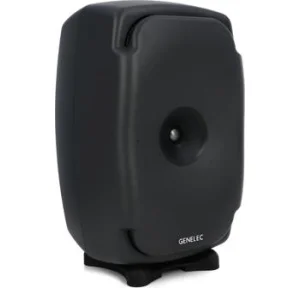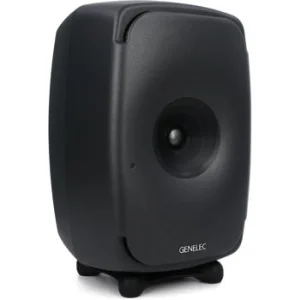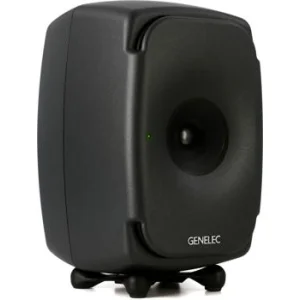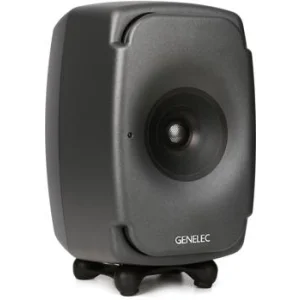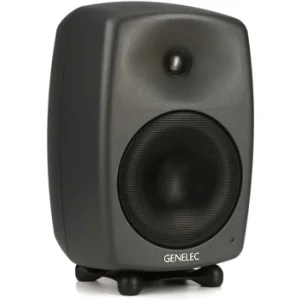A MiniDSP SHD Studio or similar is far less than that price gap. But, also - 330w for one driver is really about the same ballpark as 700W for 2 drivers.You must add external room correction to it, which should decrease that difference. I'd still take the 8361A, personally, but I'd hesitate seriously if the KH430 got the whole DSP package (phase correction, factory calibration, MA-1 support) and more amplifier power (its woofer gets 330W instead of 700W for the 8361A while playing a few Hz lower) while keeping the same price. Would still get the coaxial, probably.
-
Welcome to ASR. There are many reviews of audio hardware and expert members to help answer your questions. Click here to have your audio equipment measured for free!
You are using an out of date browser. It may not display this or other websites correctly.
You should upgrade or use an alternative browser.
You should upgrade or use an alternative browser.
Genelec 8361A Review (Powered Monitor)
- Thread starter amirm
- Start date
??? The combined surface (thus the excursion requirement) is similar, so I don't see why it would be similar. Unless sensitivity is really much lower on the Genelec, which is possible.But, also - 330w for one driver is really about the same ballpark as 700W for 2 drivers.
Power per driver, I mean. Each of those racetrack woofers in the Genelecs is seeing 50% of that amplifier's power. Of course the surface area comes into account here, but realistically I think 330w is enough power even with that kind of extension to have the amplifier not be the limitation.??? The combined surface (thus the excursion requirement) is similar, so I don't see why it would be similar. Unless sensitivity is really much lower on the Genelec, which is possible.
I really don't know. I mean, it's not like Genelec to put twice as needed for fun. So I really wonder if sensitivity is the reason.Power per driver, I mean. Each of those racetrack woofers in the Genelecs is seeing 50% of that amplifier's power. Of course the surface area comes into account here, but realistically I think 330w is enough power even with that kind of extension to have the amplifier not be the limitation.
A reason could be that Neumann is limited by using a boatload of chipamps (cf this post) instead of a discrete and possibly more modern design. Heat dissipation of class AB could also be a limit, even though the KH420A seem to have a quite beefy and well designed convection heatsink.
Last edited:
Pearljam5000
Master Contributor
- Joined
- Oct 12, 2020
- Messages
- 6,702
- Likes
- 8,048
So basically the 2 8361A racetrack woofers area= 10 inch "normal" woofer???? The combined surface (thus the excursion requirement) is similar, so I don't see why it would be similar. Unless sensitivity is really much lower on the Genelec, which is possible.
So basically the 2 8361A racetrack woofers area= 10 inch "normal" woofer?
Code:
Neumann spec: 265 mm (10") woofer
Genelec spec: Dual 263 x 137 mm (103/8 x 53/8 in) obround cones
area = 263 * 137 * 2 = 72062 mm²
radius = sqrt(area / pi) = 151.5 mm
diameter = radius * 2 = 302.9 mm = 11.9"Speaking of 10” woofage, has anyone heard the Mesanovic RTM10?
Listening to a pair right now
Keith
Keith
Since I’ve heard the 8361A, was wondering how the Mesanovic compare?Listening to a pair right now
Keith
Maybe the larger you make it then the thicker you have to make it too (walls), along with the added weight from the extra dimensions too - in order to keep the same "stiffness".What I find crazy is how much more the 61 weighs more than it's predecessors.
Genelec 8361A 3-way Coaxial Powered Studio Monitor
Genelec 8351B 3-way Coaxial Powered Studio Monitor
Genelec 8341A SAM 3-way Coaxial Powered Studio Monitor
Genelec 8331 SAM 3-way Coaxial Powered Studio Monitor
Genelec 8340A 6.5 inch Powered Studio Monitor
Powered Yes Yes Yes Yes Yes Power Configuration Tri-amped Tri-amped Tri-amped Tri-amped Bi-amped LF Driver Size 2 x 10" 2 x 8" woofer 2 x (6.6" x 3.5") concealed woofers 2 x (5.12" x 3.62") concealed woofers 6.5" woofer MF Driver Size 1 x 5" 1 x 5" 1 x 3.5" 1 x 3.5" - HF Driver Size 1" Tweeter 1" Tweeter 1 x 0.75" Coaxial tweeter 1 x 0.75" Coaxial tweeter 1" tweeter LF Driver Power Amp 500W 250W 250W 72W 150W MF Driver Power Amp 150W 150W 150W 36W - HF Driver Power Amp 150W 150W 150W 36W 150W Total Power 800W 550W 550W 144W 300W Maximum Peak SPL 124 dB SPL 113 dB SPL 110 dB SPL @ 1m 104 dB SPL @ 1m ≥ 118 dB SPL @ 1m Input Types 1 x XLR, 1 x XLR (AES/EBU) 1 x XLR, 1 x XLR (AES/EBU) 1 x XLR (analog in), 1 x XLR (AES/EBU) 1 x XLR (analog, AES/EBU) 1 x XLR (analog), 1 x XLR (AES/EBU) Output Types 1 x XLR (AES/EBU) 1 x XLR (AES/EBU) 1 x XLR (AES/EBU) 1 x XLR (AES/EBU) 1 x XLR Thru (AES/EBU) Other I/O 2 x RJ45 (control network) 2 x RJ45 (control network) 2 x RJ45 (GLM network) 2 x RJ45 (GLM network) 2 x RJ-45 Features DIP switches DIP switches DIP switches (standalone EQ set up) DIP switches (standalone EQ set up) - Enclosure Type Rear Ported Rear Ported Ported Ported Rear Ported Enclosure Material Die-cast Aluminum Die-cast Aluminum - - Minimum Diffraction Enclosure (MDE) Height 23.37" 17.75" 13.8", 14.5" (with stand) 11.25", 12" (with stand) 13.81" Width 14" 11.33" 9.37" 7.5" 9.37" Depth 13.625" 11" 9.5" 8.37" 8.81" Weight 70 lbs. 31 lbs. 22 lbs. 15 lbs. 18.5 lbs.
I have only compared the RTM 10s here to a pair of 8351Bs we took in p/x.Since I’ve heard the 8361A, was wondering how the Mesanovic compare?
Keith
As I noted in an earlier post on this thread, I have been listening to the 8361s in my room for about a week now. I am definitely not keeping them. Aslo, as noted earlier, I listen primarily to classical music. I am an amateur musician having played in orchestras and chamber groups and also luckily part of a musical family. We have violins, cellos and a piano in the house. I have attended classical music concerts on a regular basis since I was a child. I understand that for many of you here, this is irrelevant, subjective information that gets in the way of appreciating the measurements. I read In this thread somewhere that old people will reject accurate speakers because we (I am in my 50s) are so used to colored sound that neutrality will sound bad. I reject that condescending view. I have listened to and played classical music for decades. I know what a violin sounds like. I have also listened to classical recordings since I was a child. I do not consider myself an audiophile, but have always recognized the importance of audio equipment. I do not need to be told that most classical recordings are poorly engineered. As you might imagine, I know what records I think are beautiful and realistic.
The 8361 before correction with glm was bright, harsh, and synthetic. The sound of a violin is, in my view, one of the most beautiful sounds. I found violins and pianos on the 8361 to actually sound ugly and irritating. Like listening to a child practice violin in a small room. After correction, the bass was definitely improved, but the treble was even worse. So, I knocked down the treble levels. This helped, but still the instruments sounded synthetic and unmusical. It may have something to do with the waveguide dispersion, but I really have no idea. i can say with a fair bit of confidence that many if, not most serious acoustic music listeners, will have trouble with this speaker. The bass is, to be fair, very nice. Cellos and lower notes on pianos were fine. The very low notes were excellent, but from upper mid range on up, I think the speakers are not accurate reproducers of the sound of acoustic instruments to anyrhing approaching the level of bbc style monitors or quad esl speakers.
Anyway, I understand that many here will reject my dislike of the speaker as mere subjectivism. I think there is much confusion about what science is floating around our culture. Observation and description are as important to understanding as measurement and engineering. Robust measurements of speakers are undoubtedly important and even necessary for judging speakers, but it is not sufficient. For too long mainstream audio magazines have relied only on listener reaction. They have pushed snake oil that ASR rightly rejects. Engineering is obviously essential, but it must be combined careful listening by people with knowledge of music. I see very little of that at ASR. How often are pianos, cellos or clarinets mentioned here? As I understand it, Amir’s “subjective” review was based only on listening to one speaker. If that is so, then I think he would be better off just giving us the measurements without trying to tell us if the speaker is good. Does anyone here even listen to classical music or attend classical concerts on a regular basis? Ok, enough, I know. I just wanted to record my observations about my experience with these speakers with classical music. in Sum, I found the speakers to be somewhat shrill and artificial sounding; strings didn’t sound like they do in real life, even on recordings that do much better on other speakers. They will play very, very loud and the bass is great. “There are more things on heaven and earth, Horatio, than are dreamt of in your philosophy”.
The 8361 before correction with glm was bright, harsh, and synthetic. The sound of a violin is, in my view, one of the most beautiful sounds. I found violins and pianos on the 8361 to actually sound ugly and irritating. Like listening to a child practice violin in a small room. After correction, the bass was definitely improved, but the treble was even worse. So, I knocked down the treble levels. This helped, but still the instruments sounded synthetic and unmusical. It may have something to do with the waveguide dispersion, but I really have no idea. i can say with a fair bit of confidence that many if, not most serious acoustic music listeners, will have trouble with this speaker. The bass is, to be fair, very nice. Cellos and lower notes on pianos were fine. The very low notes were excellent, but from upper mid range on up, I think the speakers are not accurate reproducers of the sound of acoustic instruments to anyrhing approaching the level of bbc style monitors or quad esl speakers.
Anyway, I understand that many here will reject my dislike of the speaker as mere subjectivism. I think there is much confusion about what science is floating around our culture. Observation and description are as important to understanding as measurement and engineering. Robust measurements of speakers are undoubtedly important and even necessary for judging speakers, but it is not sufficient. For too long mainstream audio magazines have relied only on listener reaction. They have pushed snake oil that ASR rightly rejects. Engineering is obviously essential, but it must be combined careful listening by people with knowledge of music. I see very little of that at ASR. How often are pianos, cellos or clarinets mentioned here? As I understand it, Amir’s “subjective” review was based only on listening to one speaker. If that is so, then I think he would be better off just giving us the measurements without trying to tell us if the speaker is good. Does anyone here even listen to classical music or attend classical concerts on a regular basis? Ok, enough, I know. I just wanted to record my observations about my experience with these speakers with classical music. in Sum, I found the speakers to be somewhat shrill and artificial sounding; strings didn’t sound like they do in real life, even on recordings that do much better on other speakers. They will play very, very loud and the bass is great. “There are more things on heaven and earth, Horatio, than are dreamt of in your philosophy”.
A loudspeaker can only strive to accurately reproduce the file it is fed, little point in comparing to live music.
Keith
Keith
Yes, and I’m reasonably certain that the difference you’re describing is due to the narrower beam width of the mids/treble. You’ll probably find yourself preferring wider beam speakers like Revel for stereo reproduction of acoustic and other real instrument performances, as do I.Does anyone here even listen to classical music or attend classical concerts on a regular basis? Ok, enough, I know. I just wanted to record my observations about my experience with these speakers with classical music. in Sum, I found the speakers to be somewhat shrill and artificial sounding; strings didn’t sound like they do in real life, even on recordings that do much better on other speakers. They will play very, very loud and the bass is great. “There are more things on heaven and earth, Horatio, than are dreamt of in your philosophy”.
However, you can reproduce similar acoustic realism with Genelecs, you just need a multichannel configuration with stereo upmixing — which of course is not for everyone. But when you do and you toggle back and forth between fronts only and multichannel upmixing, it becomes extremely obvious that what you describe is due to different dispersion patterns.
it is obviously true that speakers reproduce recordings. Some recordings sound like real music than others. I have spent decades sorting through which recordings I think those are. I prefer recordings that sound like music played on actual instruments In real space. once One has found some of those recordings, that seems like a fair way to judge a speaker. Otherwise, we are left with no standard at all, and little pleasure, which, after all is why we listen to music.
Fine measuring loudspeakers simply reproduce the file more accurately, of course you may not enjoy that.
Keith
Keith
‘Fine measuring loudspeakers simply reproduce the file more accurately, of course you may not enjoy that.“
I listen to music all the time. I like the sound of real instruments well played. Many recordings are good approximations of that. Most are not It is easy to condescend and repeat empty truisms, but the 8361 in my room is not a speaker that can convey that sound or be listened to with pleasure by a knowledgeable music lover. Shouldnt a good recording of a clarinet sound like a clarinet on a good pair of speakers? Publish the measurements, by all means. They are valuable information. But maybe at least find someone with mucosal knowledge to see if the speakers are musical.
I listen to music all the time. I like the sound of real instruments well played. Many recordings are good approximations of that. Most are not It is easy to condescend and repeat empty truisms, but the 8361 in my room is not a speaker that can convey that sound or be listened to with pleasure by a knowledgeable music lover. Shouldnt a good recording of a clarinet sound like a clarinet on a good pair of speakers? Publish the measurements, by all means. They are valuable information. But maybe at least find someone with mucosal knowledge to see if the speakers are musical.
Speakers are transducers they do not know what they are playing.
Keith
Keith
There is a middle ground, I think, between totally subjective reviews that most of us have learned to disregard, and judging a speaker only on measurements. Both seem necessary to me. it takes people knowledgeable about measurements and engineering, but maybe a few musicians could help with the judgment? Otherwise, you end up with an anti scientific position that is useless because you have made it unfalsifiable.
This actually a terrible way to test a speaker, because you’re just picking recordings which might have been (foolishly) mastered to sound good on the same brand of non-neutral, colored speakers you’re used to.it is obviously true that speakers reproduce recordings. Some recordings sound like real music than others. I have spent decades sorting through which recordings I think those are. I prefer recordings that sound like music played on actual instruments In real space. once One has found some of those recordings, that seems like a fair way to judge a speaker. Otherwise, we are left with no standard at all, and little pleasure, which, after all is why we listen to music.
As a result, your collection of reference tracks could simply be those tracks which were mastered specifically to sound good on those speakers. And if those speakers deviate significantly enough from neural, then this necessarily means they will NOT sound good on neutral speakers.
Similar threads
- Replies
- 56
- Views
- 15K
- Replies
- 42
- Views
- 4K
- Poll
- Replies
- 432
- Views
- 84K
- Replies
- 359
- Views
- 71K
- Poll
- Replies
- 207
- Views
- 56K
